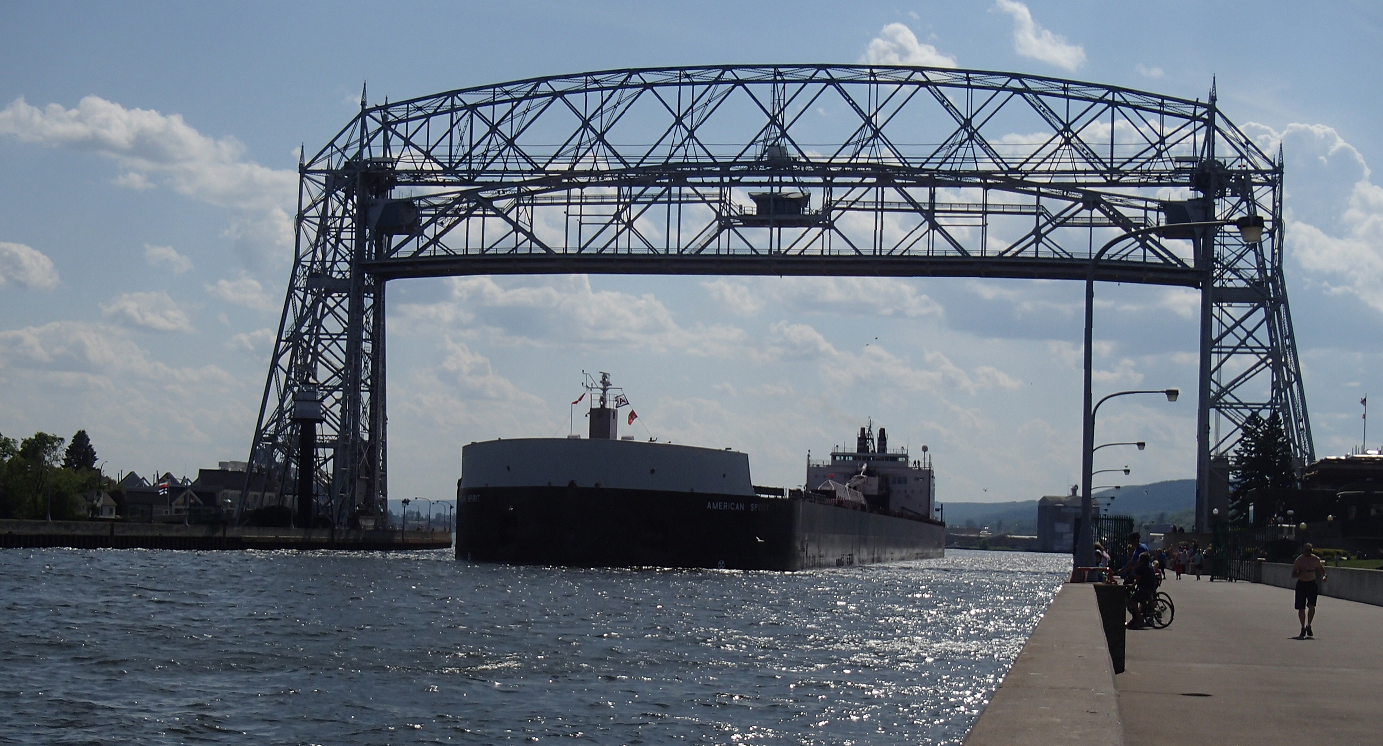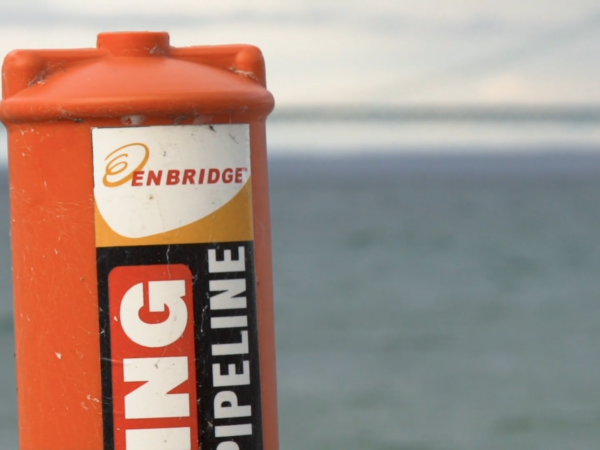
By Jim Malewitz of Bridge Magazine and Sarah Whites-Koditschek of Wisconsin Public Radio, through The Associated Press
MADISON, Wis. (AP) — More than $375 billion in cargo — iron ore, coal, cement, stone, grain and more — has flowed between Great Lakes ports and foreign nations since 1959. That is when Queen Elizabeth and U.S. President Dwight Eisenhower christened the St. Lawrence Seaway, heralding it as an engineering marvel.
But that series of locks, dams and channels connecting the Great Lakes to the Atlantic Ocean also carved a pathway for foreign plants and animals to wreak billions of dollars in ecological damage to the lakes. At least 80 invasive species have arrived in the ballast water that transatlantic ships take in and discharge for balance.
The round goby, which came from the Black and Caspian seas in the 1990s, gobbles up food some native fish depend upon. So do European zebra and quagga mussels, which also damage docks and boats and clog pipes and machinery, costing the Great Lakes region an estimated $500 million each year.
More than 20 years of federal and state efforts to regulate ballast water have slowed the introduction of new species to the Great Lakes. But those regulations exempt “lakers” — hulking freighters traveling exclusively within the Great Lakes — and researchers say that helps invasive species spread after they arrive.
___
The nonprofit news outlet Wisconsin Watch provided this article to The Associated Press through a collaboration with Institute for Nonprofit News.
___
Lakers can hold up to 16 million gallons of ballast water. The water helps ships maintain balance by dumping or replacing it as they deliver or take on cargo.
“You would expect these ships to move invasive species, and that’s what our research shows,” said Allegra Cangelosi, a Great Lakes ballast water expert and senior researcher at Penn State University-Behrend.
Canadian regulators want the country’s 80 lakers to treat ballast water by 2024, and environmentalists are pushing for similar rules for the roughly 50 freighters that fly a U.S. flag. The U.S. Environmental Protection Agency is expected to develop new standards by December 2020, and the Coast Guard plans to draft implementation rules two years after.
But industry groups argue researchers have not proved lakers move invasive species, and new regulations would cost hundreds of millions of dollars and grind business to a halt. Lakers handle about half of the $15 billion in cargo that moves around the Great Lakes each year.
For now, no treatment system cost-effectively kills unwanted organisms in laker ballast water, but scientists are racing to find a solution — and test it — before regulators finalize the new rules.
On a cold morning in November in Madison, Wisconsin, nearly a dozen University of Wisconsin-Madison students and researchers performed a tradition: removing a dock before the lake freezes.
Doctoral student Mike Spear showed off one wooden piling plucked from the water. Five years ago, it would have looked bare. Now, quarter-inch-sized zebra mussels completely covered it.
Spear scraped the creatures into a plastic bag. He estimates the mussels in Lake Mendota number in the “billions” since they were discovered in the Madison-area lake 80 miles west of Lake Michigan in 2015.
A biologist first spotted them in 1988 in North America in Lake St. Clair between lakes Erie and Huron. Cargo ships traveling from the Black Sea likely dumped ballast water laden with mussel larvae, according to the Great Lakes Aquatic Nonindigenous Species Information System (GLANSIS). Within two years, mussels had spread to all five Great Lakes, likely in ballast water of commercial ships — possibly including lakers.
The mussels can survive days outside the water, reaching hundreds of inland lakes by latching onto boats, bait buckets and trailers, clogging the pipes of power plants and water systems.
Zebra mussels are among 187 nonnative species established in the Great Lakes. The takeover of North American waterways by invasives has galvanized scientists and policymakers. Wisconsin now requires boaters and anglers to inspect and remove invasives from their vessels.
Ocean-going ships called “salties” — which have been linked to introductions of 80 unwanted species to the Great Lakes — are required to take steps to curb invasives. But laker ballast water remains unregulated, making it tougher to limit damage from other invaders, researchers say.
“All nature has to do is drop in a bad actor,” Cangelosi said, “and we’re sunk.”
Over the past decade, scientists have confirmed just three new species to reach the Great Lakes; none of them arrived in ballast water. The last species to do so was the bloody red shrimp in 2006, whose impact is not yet clear.
Experts credit the progress to ballast water exchange or “swish and spit.” Since 2006, U.S. and Canadian governments have required salties to dump water they took in at foreign ports in the middle of the ocean, replacing it with salt water likely to kill freshwater creatures hiding in their tanks, before reaching the Great Lakes.
For some ships, that can mean also treating ballast water with chemicals, filtration, ultraviolet treatment or other methods.
“For the last 20 years we’ve been so focused — and rightly so — on the things coming from outside the Great Lakes,” said Rochelle Sturtevant, who manages GLANSIS for the Michigan Sea Grant Extension. “As the data is starting to show, we’ve got that mostly under control, maybe it’s time to start revisiting some of these things like spread.”
Some 20% of the Great Lakes’ nonnative species have reached all five lakes, and unregulated ballast water of lakers “may pose a relatively high risk” of aiding the invaders, said Sturtevant, quoting from a not-yet-released State of the Great Lakes 2019 report authored by more than 180 scientists.
Inside a University of Wisconsin-Superior laboratory, researchers tested a potential weapon against unwanted species lurking in laker ballast water.
A metallic box roughly the size of a TV cabinet hissed as water cycled through from a tank. The contraption zapped any tiny organisms inside with bubbles that delivered ozone. Such technology already treats toxic algal blooms in ponds, said Kelsey Prihoda, a researcher with UW-Superior’s Lake Superior Research Institute.
Her team was examining whether the prototype could kill invasive species in laker ballast water.
“One day they hope to have it on board ships,” Prihoda said.
That is unlikely to happen without new regulations.
When the EPA overhauled ballast water regulations in 2013, the agency exempted lakers built before 2009, citing a lack of available technology. A federal appeals court called that decision “arbitrary and capricious” and instructed regulators to reconsider the issue. Experts acknowledge ballast water exchange does not work well for freshwater vessels, and a variety of factors make treatment more difficult.
Unlike in salties, lakers’ steel ballast tanks lack coating to prevent corrosion from treatment chemicals, said Tom Rayburn, director of environmental and regulatory affairs for the Lake Carriers’ Association, which represents American laker companies. Lakers also take in far more ballast water than salties and make relatively short voyages.
Treating all that water could take up to 72 hours — double or triple the length of a trip, Rayburn said.
In addition, outfitting every American laker with ballast water treatment systems would cost $639 million, atop $11 million each year to maintain and operate, the Lake Carriers’ Association said. The costs did not include the lakers’ time out of service during the upgrades.
Transport Canada, the country’s transportation agency, has proposed requiring its 80-laker fleet to install ballast water treatment systems by 2024. But Rayburn said the price tag for U.S. freighters would be higher. Canadians can buy cheaper ships built abroad, he said, while Americans are required to buy U.S.-made ships.
Rayburn’s group also questions whether lakers are responsible for invasions of nonnative species.
In 2017, UW-Superior researchers tested the ballast water tanks of eight U.S. and Canadian lakers traveling to western Lake Superior. Their 2018 report documented several species of zooplankton no one had previously recorded in Lake Superior — one of which had never been found in any Great Lake. The report followed Canadian research that found nonnative species in 90% of laker ballast water samples.
The Lake Carriers’ Association cooperated with the researchers by allowing them to board the ships and collect samples. But the group interpreted the results differently.
It criticized the study’s sampling as limited, and said it did not prove that laker-transported species could survive in new lakes.
“Let’s do some more work and get some more data to determine whether this study is telling us something new, or if these are limited data points that don’t reflect bigger issues and trends in the Great Lakes,” Jim Weakley, the group’s president, said following the report’s release.
Prihoda, the UW-Superior researcher, acknowledged research is scarce about whether species were established in new lakes after riding in laker ballast tanks.
But, she said, “The thing is, once an organism becomes established, it could become invasive and spread. (It is) too late at that point to do anything about it.”
The Lake Carriers’ Association declined to allow Wisconsin Watch/Wisconsin Public Radio and Bridge Magazine to board a ship to report this story. Rayburn said the UW-Superior study made captains more hesitant to welcome outsiders.
“We just want this to be more educational than judgmental,” he said.
Ballast water legislation signed by President Donald Trump in December was a compromise between environmentalists and the shipping industry. It preserved the EPA’s Clean Water Act Authority to set ballast water standards, but it also made it difficult for states to set their own, stricter rules.
Coast Guard spokesman Richard Everett said whether the new EPA standards would apply to lakers is still to be decided.
The law includes $50 million for invasive species prevention efforts, which Molly Flanagan, vice president for policy at the Chicago-based Alliance for the Great Lakes, said could be used for research.
“We’re rapidly going to be running up against a situation where lakers are out of excuses and are going to have to treat their ballast water,” she said.
Said Penn State’s Cangelosi: “I feel for the lakers because they are not bringing these things in (from overseas). A lot of the things that we worry about come in with the salties, and then the lakers are caught holding the bag — moving it all around the lake.”
Featured Image, A freighter leaves Duluth, Minn., heading out to Lake Superior, Photo by Sandra Svoboda




